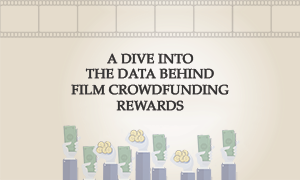 This week, I’m celebrating the launch of my new book ‘How To Crowdfund Your Film‘. It’s published by Creative Essentials in physical and Kindle editions. To coincide with the launch, I thought I would tackle a related question from a reader who got in touch to ask about the rewards offered on crowdfunding sites. In the past, I have looked at the number of rewards offered but this reader was specifically asking about the success of different types of rewards. i.e. not what filmmakers want to offer but rather what backers want to accept. So I gathered data on rewards for all Kickstarter film projects launched between April 2009 and May 2018 – that’s 466,998 rewards in total – and set to work.
This week, I’m celebrating the launch of my new book ‘How To Crowdfund Your Film‘. It’s published by Creative Essentials in physical and Kindle editions. To coincide with the launch, I thought I would tackle a related question from a reader who got in touch to ask about the rewards offered on crowdfunding sites. In the past, I have looked at the number of rewards offered but this reader was specifically asking about the success of different types of rewards. i.e. not what filmmakers want to offer but rather what backers want to accept. So I gathered data on rewards for all Kickstarter film projects launched between April 2009 and May 2018 – that’s 466,998 rewards in total – and set to work.
A quick primer on crowdfunding
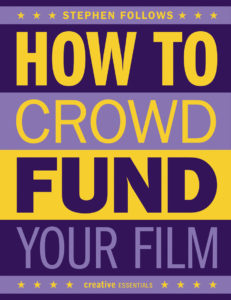 Let’s start with a very quick overview of how crowdfunding works. A filmmaker will create a project on a crowdfunding site where they tell the public about their proposed film. They will use text, imagery and often a video to explain what they want to do, how much they need to raise (i.e. their ‘target’) and what backers will get in return for supporting the project (i.e. the ‘rewards’). They also set a timeframe, such as 30 days. During this time, the page will be available to the public who can decide if they want to back the project, and if so, how much money they want to pledge. Once the deadline has been reached, one of two things will happen:
Let’s start with a very quick overview of how crowdfunding works. A filmmaker will create a project on a crowdfunding site where they tell the public about their proposed film. They will use text, imagery and often a video to explain what they want to do, how much they need to raise (i.e. their ‘target’) and what backers will get in return for supporting the project (i.e. the ‘rewards’). They also set a timeframe, such as 30 days. During this time, the page will be available to the public who can decide if they want to back the project, and if so, how much money they want to pledge. Once the deadline has been reached, one of two things will happen:
- Success! If enough people have pledged to support the project then the credit cards of all the backers will be charged, the filmmakers will get the money (minus the site’s fee of around 5%) and they will set about making their movie.
- Failure. If the amount pledged is less than the target amount then no one is charged any money and the filmmakers get nothing. (A few sites like Indiegogo offer a flexible funding option whereby filmmakers get to keep whatever they raise, even if they miss the target).
If the project has been a success, then the filmmakers are responsible for delivering to backers whatever they promised during the campaign.
Awarding rewarding rewards
When designing rewards, filmmakers have a lot of freedom. They can choose how many different levels of rewards there are, how much a backer would need to donate to attain each level and what the backer receives in return. Popular examples of rewards on film projects are:
- For low amounts ($’00s) the rewards tend to be digital or virtual, such as a tweet to say thank you, access to a private blog or vlog series or a digital copy of the script.
- For medium amounts ($’000s) they are more akin to merchandise, such as a copy of the finished film on DVD, tickets to a screening or a t-shirt.
- For large amounts ($’0,000s) the rewards are experiential or ‘money can’t buy’, such as a producer credit, attending the set or being in the film as an actor/extra.
Each crowdfunding platform has their own rules as to what kinds of rewards are not permitted. The vast majority do not allow backers to receive money or a share of the income/profits as this would be regarded as an investment, which is a heavily regulated activity. Kickstarter is more restrictive than its major rival IndieGoGo. Among the things you can offer on Indiegogo but cannot on Kickstarter are medical cures, energy food/drink, pornography and just reselling items. 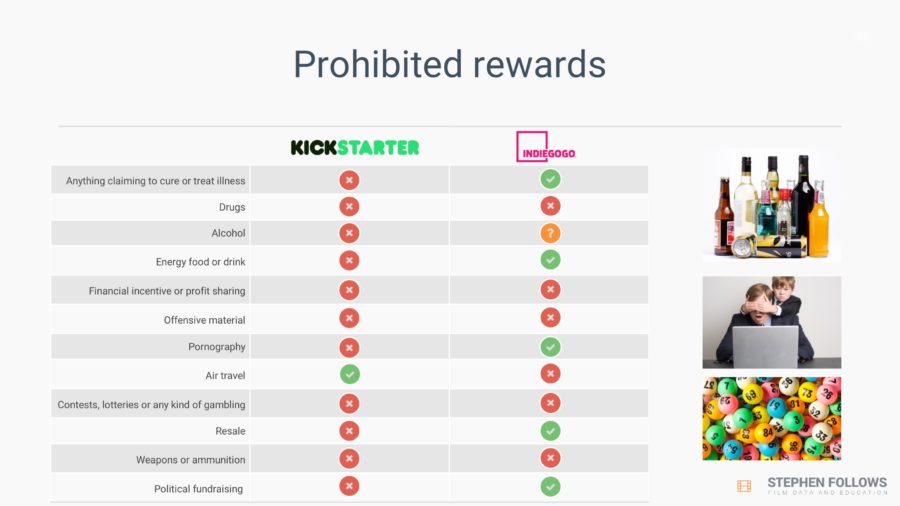 Across the Kickstarter film campaigns I studied for this research, the average project had eight rewards. Half of all projects offered fewer than eight rewards, and 3.3% offered more than twenty. Projects offering a large number of rewards included “The Wrecking Crew” The Untold Story of Rock & Roll Heroes (which offered 127 reward tiers) and From Here to There: A Parkour & Freerunning Doc (130 rewards).
Across the Kickstarter film campaigns I studied for this research, the average project had eight rewards. Half of all projects offered fewer than eight rewards, and 3.3% offered more than twenty. Projects offering a large number of rewards included “The Wrecking Crew” The Untold Story of Rock & Roll Heroes (which offered 127 reward tiers) and From Here to There: A Parkour & Freerunning Doc (130 rewards). 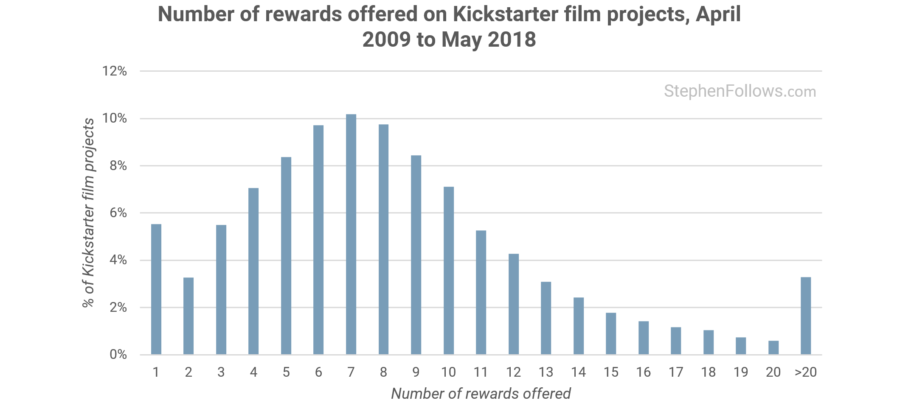 Over time, the number of rewards offered on film Kickstarter projects has increased. In 2009, the average was six but just four years later that had increased to ten.
Over time, the number of rewards offered on film Kickstarter projects has increased. In 2009, the average was six but just four years later that had increased to ten. 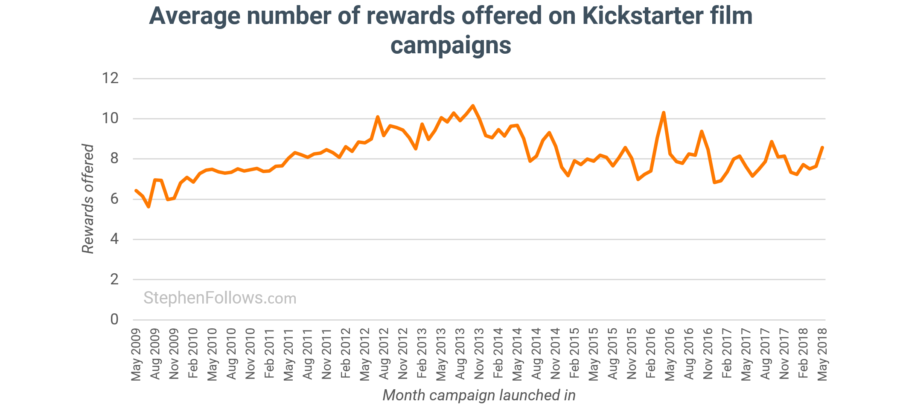
What are the most frequently offered film crowdfunding rewards?
There are two ways we can measure the rewards – what’s been offered by filmmakers and what’s been claimed by backers. A film may offer three rewards tiers – $10 for a poster, $20 for a DVD and $30 for a t-shirt. Let’s say that once the project was funded, four people claimed the poster, three people claimed the DVD and one person claimed the t-shirt. If we focus on what’s been offered then the data shows that 33% of rewards are posters, 33% are DVDs and 33% are t-shirts. However, if we focus on what was claimed, 50% were posters, 37.5% were DVDs and 12.5% were t-shirts. The reason for looking at the data in both of these two viewpoints is that they measure different things. The first tells us what filmmakers are willing/ able to give, whereas the second (and arguably more important) reflects the public’s demand and taste. Let’s start with what’s on offer. The most frequently offered reward is a credit as a producer, with 58% of all projects offering it. Close second was a copy of the finished film on DVD (55% of projects) and a copy of the film’s poster (40%). 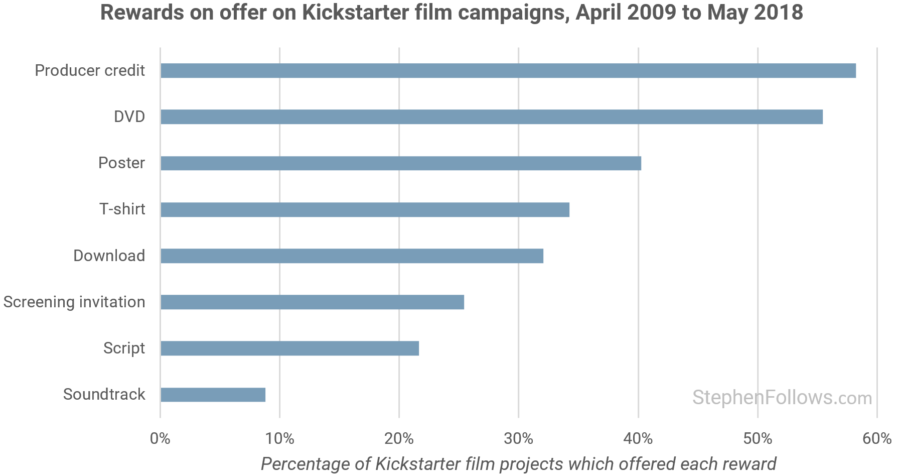 Interestingly, the most frequently offered reward also costs the highest price. To determine this, I looked at the lowest amount of money a backer would need to spend on each project to receive each of the offered rewards. Across all projects, the median amount you would need to spend to get a download of the film was $20. Other relatively cheap items include a copy of the soundtrack ($40), a DVD ($45) and a poster ($50). An invitation to a physical screening is typically listed at $288 and a producer credit is a whopping $500.
Interestingly, the most frequently offered reward also costs the highest price. To determine this, I looked at the lowest amount of money a backer would need to spend on each project to receive each of the offered rewards. Across all projects, the median amount you would need to spend to get a download of the film was $20. Other relatively cheap items include a copy of the soundtrack ($40), a DVD ($45) and a poster ($50). An invitation to a physical screening is typically listed at $288 and a producer credit is a whopping $500. 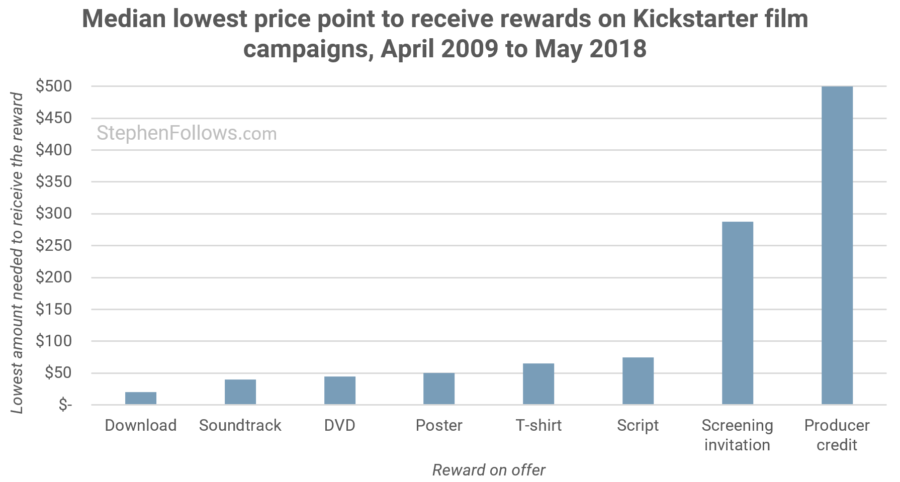
Which rewards do crowdfunding backers actually want?
Let’s turn to the second way of looking at the rewards data – what backers are claiming. Across all of the projects I studied, 3,313,970 rewards were claimed (this is on both successful and unsuccessful projects). Of the popular rewards mentioned above, the most frequently claimed was a download of the film, most likely due to its cheap price point. 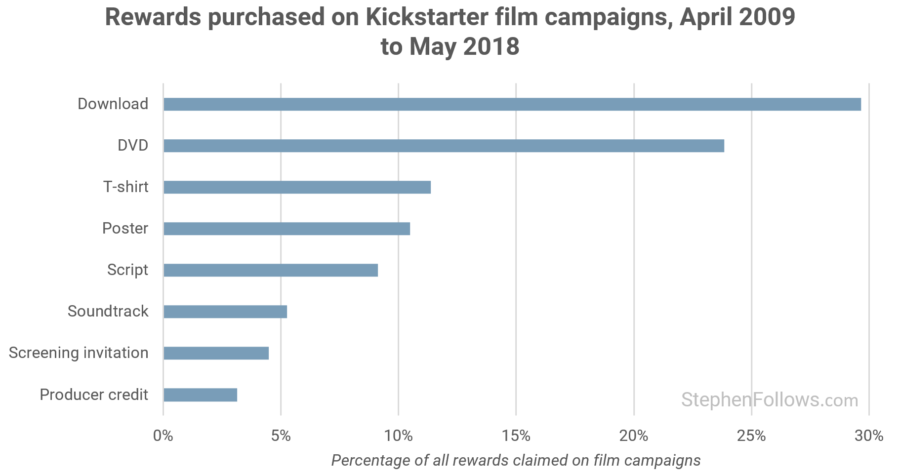
The world’s top Producer producer
Throughout the history of film, no one single company has done more than Kickstarter to increase the number of credited film producers. In the past nine years, successful projects on Kickstarter have given out 85,438 producer credits. The most common type of producer credit is that of Associate Producer. 38% of Kickstarter film projects offered this as a reward and to date, 23,989 have claimed one via backing a successful project. In case you were wondering what an Associate Producer credit means, I refer you to David Mamet’s withering description in his wonderful movie State and Main in which he says it’s “what you give to your secretary instead of a raise”. 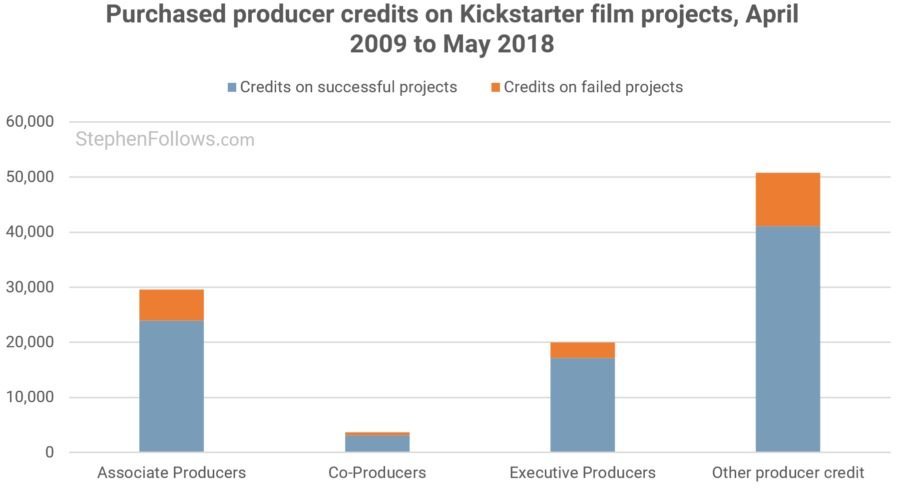 N.B. credits include full Producer credits, Supporting Producer credits and many other types. Receiving a credit on IMDb seems to be something filmmakers are keen to mention. 13% of projects name-check IMDb in at least one of their rewards.
N.B. credits include full Producer credits, Supporting Producer credits and many other types. Receiving a credit on IMDb seems to be something filmmakers are keen to mention. 13% of projects name-check IMDb in at least one of their rewards.
Late rewards
From mid-2011, Kickstarter required that filmmakers add an ‘estimated delivery’ date to each reward. The reliability of rewards delivery has long been an issue with crowdfunding. Once a project is successful and the money transferred from backers to filmmakers, the crowdfunding platform does not have any responsibility for if or when the rewards are delivered. It’s entirely up to the filmmakers to deliver on their promises. In some cases, projects can go wrong or filmmakers can become unresponsive, leading to frustrated backers. The addition of these dates was a step towards easing this pain, as it allows filmmakers to be held to account but also to ensure that backers have realistic expectations (i.e. filmmakers have to actually make the film before they can send out DVDs!) I gathered these estimated delivery dates and compared them to the deadline date of the campaign. Across all projects, the average estimated delivery was 24.7 weeks (i.e. around six months from when the campaign closed). 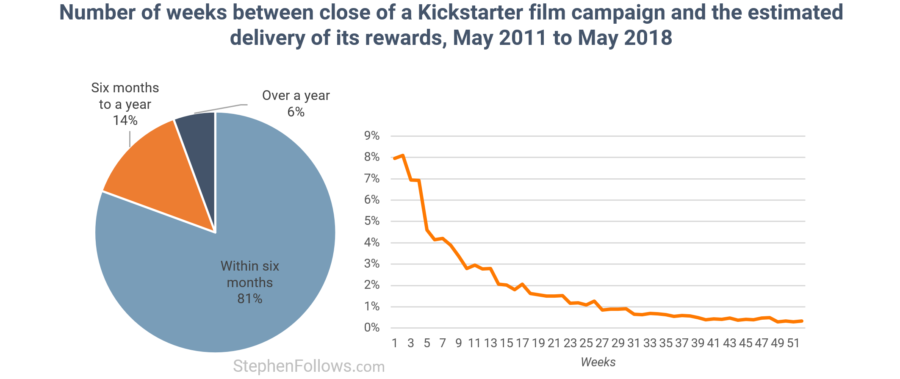 Over time, filmmakers seem to have cottoned on to the fact that rewards can take some time to be delivered. Since 2011, the average length of time filmmakers have estimated their rewards will take to deliver has risen (from 16 weeks in 2011 to 18 weeks in 2016) and then fallen back down (to 15 weeks so far in 2018).
Over time, filmmakers seem to have cottoned on to the fact that rewards can take some time to be delivered. Since 2011, the average length of time filmmakers have estimated their rewards will take to deliver has risen (from 16 weeks in 2011 to 18 weeks in 2016) and then fallen back down (to 15 weeks so far in 2018). 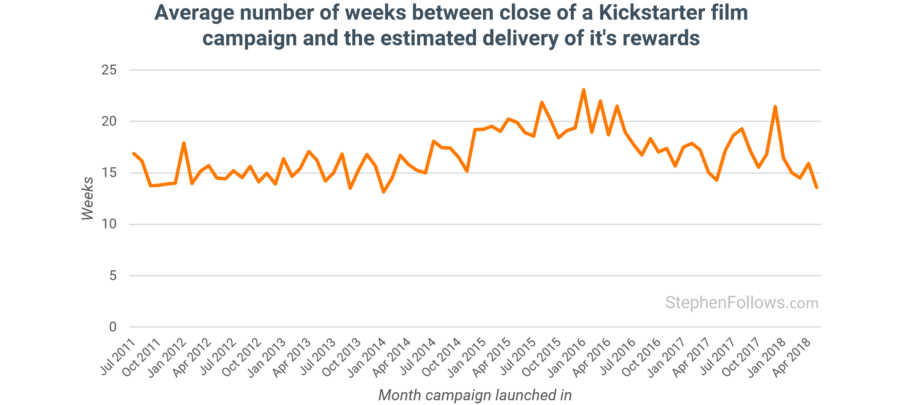 Last year, a team of researchers from Utah State University published a research paper entitled ‘Identifying On-time Reward Delivery Projects with Estimating Delivery Duration on Kickstarter‘. They studied 2,198 Kickstarter projects (across all categories) and determined whether each had delivered their promised returns on time. Only 36% of film projects delivered on time, placing ‘film’ 12th in the league table of Kickstarter’s 15 project categories, ahead only of games, technology and comics. A further paper by the same team entitled ‘Characteristics of On-Time and Late Reward Delivery Projects‘ looked at what factors affected the likelihood of rewards being delivered on time. Among the factors which correlated to increased reliability were lower target amounts, fewer rewards and higher community engagement, such as posting updates and comments on the Kickstarter page. In their words: “We found that less complicated projects with more active response to backers had a higher chance to ship rewards on time“. Interestingly, one factor which did not seem to matter was how long the creators had given themselves to deliver the rewards. As the researchers put it: “Even 44% projects, whose duration was greater than 10 months, were late delivery projects. It indicates that longer delivery duration does not always increase a proportion of on-time delivery projects“.
Last year, a team of researchers from Utah State University published a research paper entitled ‘Identifying On-time Reward Delivery Projects with Estimating Delivery Duration on Kickstarter‘. They studied 2,198 Kickstarter projects (across all categories) and determined whether each had delivered their promised returns on time. Only 36% of film projects delivered on time, placing ‘film’ 12th in the league table of Kickstarter’s 15 project categories, ahead only of games, technology and comics. A further paper by the same team entitled ‘Characteristics of On-Time and Late Reward Delivery Projects‘ looked at what factors affected the likelihood of rewards being delivered on time. Among the factors which correlated to increased reliability were lower target amounts, fewer rewards and higher community engagement, such as posting updates and comments on the Kickstarter page. In their words: “We found that less complicated projects with more active response to backers had a higher chance to ship rewards on time“. Interestingly, one factor which did not seem to matter was how long the creators had given themselves to deliver the rewards. As the researchers put it: “Even 44% projects, whose duration was greater than 10 months, were late delivery projects. It indicates that longer delivery duration does not always increase a proportion of on-time delivery projects“.
Notes
Today’s data relates to all film projects listed on Kickstarter between April 2009 and May 2018. This includes short films, feature films and film series, both documentary and fiction. Across all Kickstarter film projects, 86.2% use US dollars, 10.0% use GB Pounds, 2.4% use Euros and the other 1.5% use other currencies. Any findings in today’s research referring to money were drawn from the projects that used US dollars. I considered converting the other 13.8% of projects into dollars to include them but it would have meant taking into account ever-changing exchange rates and I felt it was unnecessary given how many projects were already in US dollars. The terminology differs slightly across crowdfunding platforms. Indiegogo calls rewards ‘perks’.
Epilogue
 If you’re interested in knowing more about crowdfunding and how you can use it to fund your film, then consider buying a copy of my new book ‘How To Crowdfund Your Film‘. In addition, here are some of the articles I’ve written on the topic in the past:
If you’re interested in knowing more about crowdfunding and how you can use it to fund your film, then consider buying a copy of my new book ‘How To Crowdfund Your Film‘. In addition, here are some of the articles I’ve written on the topic in the past:
- The statistics behind film crowdfunding: Part 1
- Film crowdfunding tips – What the data says you should do
- How many filmmakers run multiple crowdfunding campaigns?
- How much do Kickstarter film projects aim to raise?
- Is Seed & Spark’s high crowdfunding success rate for real?
- The film financing of a £660k feature film

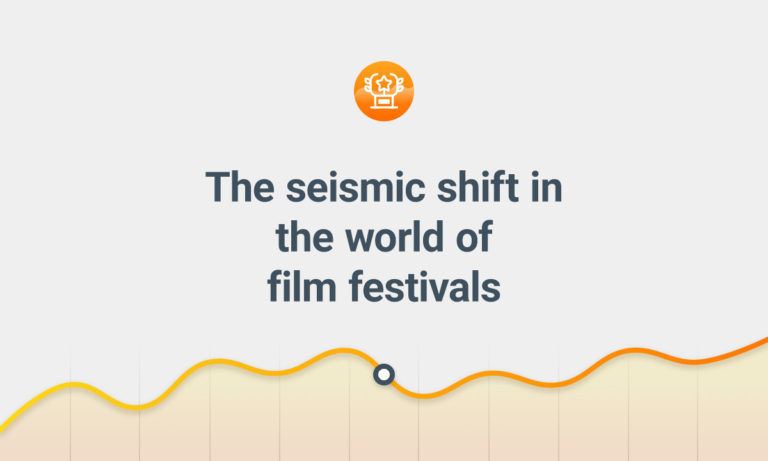
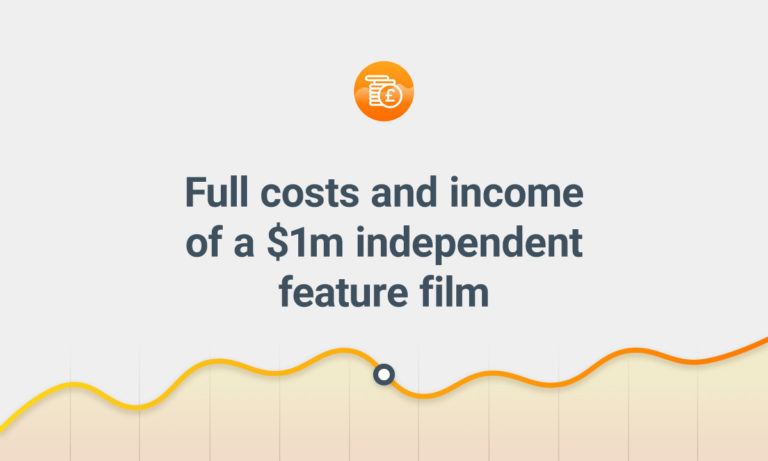
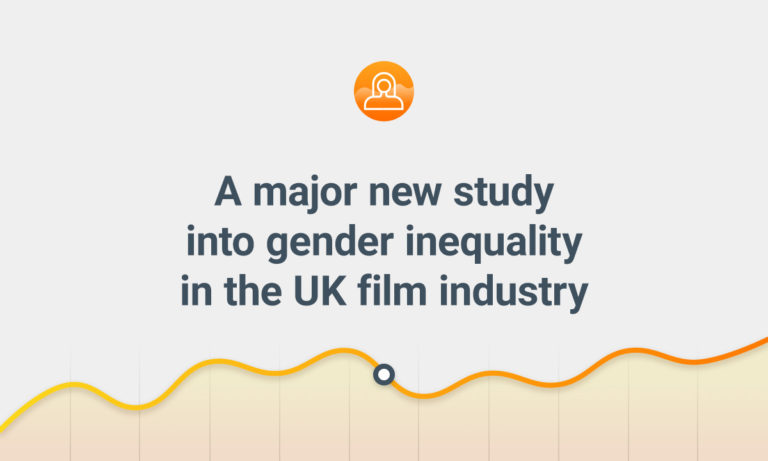

Comments
Great article! I wish I could get the book on Kindle in the U.S.
Fear not – you can! https://www.amazon.com/How-Crowdfund-Your-Film-Strategies-ebook/dp/B076H2FTP1/